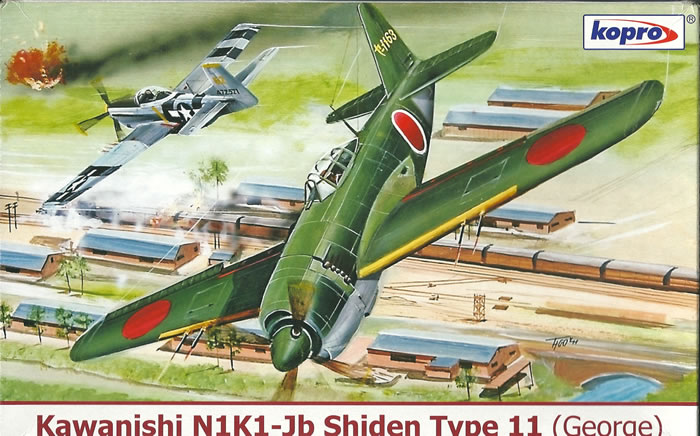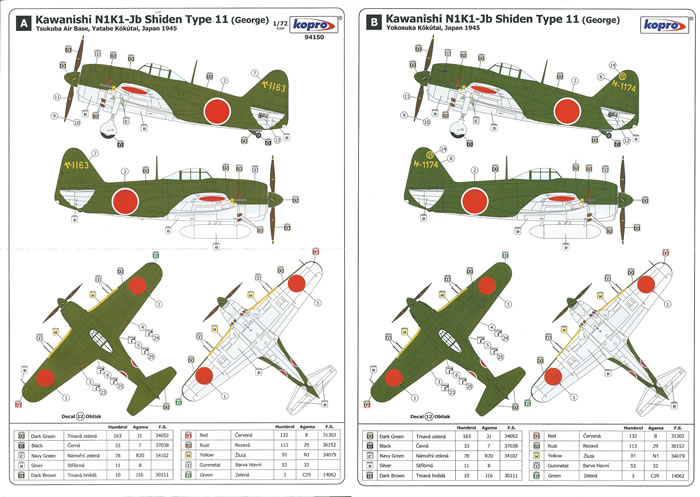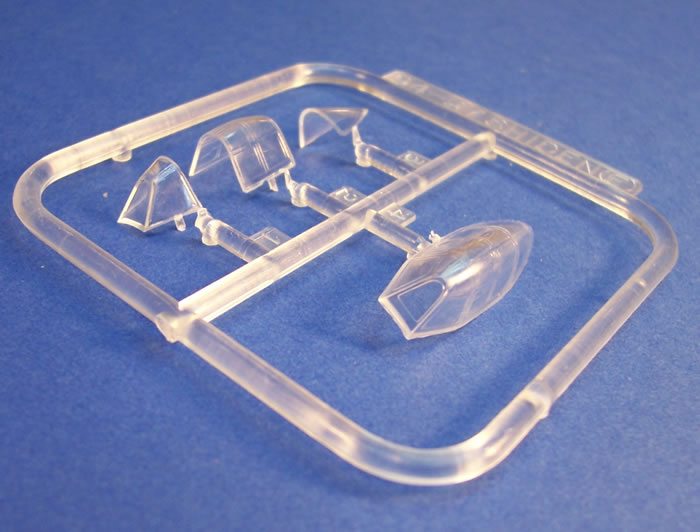Kawanishi N1K1-Jb Shiden Type 11 (George)

Kopro, 1/72 scale
S u m m a r y : |
Catalogue Number: |
Kopro Kit No. 74157 - Kawanishi N1K1-Jb Shiden Type 11 (George) |
Scale: |
1/72 |
Contents & Media |
Four clear and thirty-two grey styrene parts, with decals for two subjects. |
Price: |
Available online from Hobbyshop.cz for €9.03 ($10.83 with Tax)
|
Review Type: |
First Look. |
Advantages: |
Great value, nice moulding, fine panel lines, simple assembly, thin clear parts with open and closed canopy options, and nice decals. It has a reputation of being very good to build. |
Disadvantages: |
The fabric effect on control surfaces is a bit exaggerated. The parts map numbering does not correspond to the numbers moulded on the sprues. |
Conclusions: |
This very good value re-box of the Aoshima kit is simple and trouble free to build. It compromises on cockpit and engine detail a bit, but this hardly matters. The engine can be barely seen, and the cockpit is small with quite a bit of canopy framing. There is an open canopy option; which if used will demand some additional cockpit detail in my view. The scale finesse is generally very good, so an out of the box build should look most presentable. Recommended. |
Reviewed by
Mark Davies

HyperScale is proudly supported by
Squadron.com
Most floatplane fighters were derived from land-based aircraft. The Zero, Spitfire, and Wildcat are just some examples of WW2 fighters with floatplane derivatives. To take the reverse path and develop a land-based fighter from a floatplane is most unusual, yet this is how the Kawanishi Shiden came to be. Not only is it unique in this respect, but the Shiden was widely regarded to be one of the best Japanese fighters of WW2.
The Shiden progenitor was Kawansihi’s N1K1 Kyofu. Its role was to provide fighter cover where land-based fighters could not operate for lack of runways, and in the absence of carrier-borne support. Kawanishi designed the Kyofu as a floatplane fighter from the outset. Its development problems soon caused delays, many being due to the use of contra-rotating propellers. Meanwhile, Nakajima was assembling the Mitsubishi A6M3 Reisen (Zero) under licence. Nakajima concluded that a floatplane fighter could be developed quickly form this outstanding design. They proceeded to produce a floatplane derivative of the Zero, known as the A6M2-N, which entered service in mid-1942.
Work continued on the Kyofu as it offered better performance than the A6M2-N. The Kyofu was powerful and portly; yet it still had a managed to appear somewhat elegant. It used a mid-wing layout using a large centre float and small outboard stabilisers. The war situation no longer favoured the Japanese by the time the Kyofu was ready for service. By then the need was for fighters able to deal with the new and superior American designs, not ones with compromised performance due to high-drag floats. Japanese carrier losses, and the need to defend island conquests, both meant that powerful land-based fighters were to be the IJN’s answer to the new enemy threat.

As it happened, Kawanishi had designed a land-based fighter based on the Kyofu. Named the Model-X-1, it was designed at the time the Kyofu was still a prototype. However, the IJN had ordered the Mitsubishi J2M Raiden to be its first land-based fighter design; so they showed little interest in X-1. This meant that Kawanishi had to continue with the X-1 as a private venture.
The X-1 was closely based on the Kyofu to speed its development, although it used a more powerful engine. The X-1 had the same mid-mounted wing as the kyofu, and this meant it needed a long undercarriage. Kawanishi was a builder of flying boats and floatplanes, and had little to do with undercarriage design. There were constant problems due to the complexity of the X-1‘s telescopic undercarriage. Furthermore, the X-1 also had problems with engines that failed to reach their rated power output as well as proving to be unreliable.
Kawanishi had however begun to change the X-1’s design before its problems became fully apparent. This redesign used a low-wing that solved the undercarriage problems and simplified the aircraft’s structure. It was at this point that the IJN chose to sponsor the project. The IJN freed Kawanishi from some commitments to let them focus on developing their new fighter.
The IJN tested one of four X-1 prototypes meanwhile. The tests confirmed many of its weaknesses as well as revealing some of its potential. Mitsubishi also had problems with the Raiden’s development at this time. The Raiden was the IJN’s sponsored design for a land-based fighter, so it is ironic that Mitsubishi’s problems led the IJN to order the X-1’s production as a rival design. The production version of the X-1 was named the N1K1-J Shiden; it was to be a stopgap measure pending the development of the improved low-wing version. The Shiden went into service early in 1944, and had some successes in the defence of the Philippines, Formosa and Okinawa. The Japanese produced just over 1,000 Shidens, despite the design’s stopgap nature.
The improved version was named the N1K2 Shiden-kai. Its low wing position meant that it had a shorter undercarriage; thus resolving a major weakness of the N1K1 series. It also had a slightly longer fuselage, a different tailfin, and cleaner lines to its engine cowl. Less obvious was the fact that it was easier to build with around 23,000 fewer parts than the Shiden due to its simplified structure; and this parts count excludes screws and rivets! The Shiden-Kai was superior in several respects when compared to the Raiden; it was slightly faster, more manoeuvrable, had longer endurance, and gave the pilot better visibility. It was by 1945 the IJN’s favoured fighter design. However, like many Japanese aircraft towards the war’s end, poor engine reliability plagued the design. It confronted American fighters on roughly equal terms, but lacked performance at high altitude to deal with B-29 raids. In the end, it was another case of too little too late.
Previous 1/72 Scale Shiden Kits
I am aware of five previous N1K1 Shiden kits in 1/72-scale. Red Baron offered a resin kit, whilst Nitto/Panda, MPM, Aoshima and Tamiya all released injected kits. Only two of these are still produced and worthy of consideration, these being the Tamiya and Aoshima kits. The Aoshima kit is in fact the same as the review kit, which Kopro has re-boxed, along with Aoshima’s other kit of the in N1K1 in “-Ja” form; so I shall describe it below. The Tamiya kit is the N1K1-J Type 11 with two cannons in the wings and two in underwing gondolas. Tamiya calls their kit a N1K1-Ja, but some of my references indicate it is a Shiden-J. It is of the quality we have come to expect of Tamiya 1/72-scale kits in general.
It is worth mentioning that Nitto/Panda, Hasegawa and Aoshima have all released 1/72-scale kits of the N1K2 Shiden-Kai. The 1970’s Panda kit is mainly of novelty value; whilst the Hasegawa kit is I think a mid-1980’s release that has fine panel lines, and is a simple and honest kit to build. The Aoshima kits of the N1K2-Ja and “-Ja” are the best by far, and unsurprisingly are very similar to the Shiden kit reviewed here. Kopro has also re-boxed both of these kits.
If the Kyofu appeals to you look no further than Hasegawa who offer three versions including the prototype. These are all simple but very nice kits that include a beaching trolley. There have been several other kits as well - In resin from CMR, A+V Resin, and Aviation USK; as vac-forms from O’Neil Vac-forms and Eagles Talon; and a limited run injected kit from High Planes.
The Contents
The review kit is a Korpro re-box of Aoshima’s Shiden kit that was first released in the mid-1990s. Without getting too far ahead of things, let me make it very clear that this kit is nothing like the Aoshima aircraft kits from an earlier period; so even if you have are aware of these dreadful offerings please read on.
The kit comes in a top-opening box with artwork a little reminiscent of some 1950s and 1960s brands. The aircraft are rendered well enough, but the background is very simplified. However, this matters little.
Inside the box, and aside from the parts and decals, are some very simple but effective enough instructions. These have English and Czech instructions along with a brief aircraft history, a parts map and clear assembly diagrams. The parts map numbering does not correspond to the numbers moulded on the sprues; but this is a minor matter. The instructions cross-reference paint call-outs to Humbrol, Agama and FS.595. The four-view painting and decal guide is in glossy colour print, and repeats the colour cross-references. The four main sprues are enclosed in two cellophane bags, with the clear parts unprotected in a bag with two other sprues and the decals are loose in the box.
The quality and style of the parts compare very much to those of Hasegawa kits of the 1990’s. This was so apparent that I wondered for a moment if Hasegawa had produced them under contract! The plastic is of a similar nature, sprue style and gates are likewise, and surface detail mainly consists of fine recessed panel lines.
The Airframe
Assembly of the kit is straightforward and largely conventional for the type. It starts with the cockpit interior that includes a floor, the pilot’s seat and the structure behind it, an instrument panel, and a control column. The instrument panel uses a decal for the dials and includes a gun-sight. The interior detail is of similar standard to that found in Hasegawa kits from the 1990’s. As such, it is adequately representational for a closed canopy model; as not a lot is visible through the clear but small framed canopy. I think that it needs additional detail if the kit’s open canopy is used. The clear parts are both thin and very transparent.
The simplified engine has both cylinder rows made as one piece, and features basic cylinder heads and thick cooling fins. The reduction gear housing and the main ignition cable manifolds are a single part that attaches to the front row of cylinders. This part alone will mainly be visible through the small gap between the spinner’s base and the mouth of the closely cowled engine. This means that the lack of good cylinder detail is almost irrelevant. A nicely done propeller and spinner finish off the engine; along with small ejector exhaust stubs that look okay moulded with the fuselage halves.
The kit’s cowl has two machine gun troughs present even though the N1K1-Ja/b only had four internal wing cannon. I have looked at various plans of this version and all show the troughs in place. I have had less luck with photos because the shots that show two internal wing cannon present tend not to show the cowl clearly and vice-versa. Maybe the N1K1-Ja/b retained the earlier version’s style cowl even though the machineguns were deleted.
There are very few parts to assemble once the cockpit and engine sub-assemblies are complete and ready for fitting in the fuselage. The kit’s surface detail consists of fine recessed panel lines and slightly exaggerated fabric effects on the control surfaces. Some may choose to reduce the exaggerated sagging with a lick of filler and gentle sanding. The wing has three parts including the four cannon barrels. The fuselage has two halves and the one-piece engine cowl, plus of course the horizontal stabilisers. There are rounded and squared off styles of horizontal stabiliser to allow for either Shiden-Ja or “-Jb” boxings. The review kit uses squared off kind.
Remaining detail parts include the undercarriage and drop tank. The undercarriage legs have the smaller doors moulded with them. They are nothing special to look at, but are typical in terms of detail for the period from which the kit originates. The wheels are good, and there is some detail in the main wheel wells, although these are little shallow. The drop tank is simple but adequate, and is in keeping with the rest of the kit.
My descriptions so far have been of a slightly bland and adequate kit that is extremely simple to build. This is I feel an accurate description, but also one that sells the kit a little short. This kit really will seem to be of superior quality and have greater appeal built than it does unassembled in the box. I say this because I anticipate it being a breeze to assemble, and it has some very nice scale finesse. The detail aspects I described as being just adequate will hardly be apparent on a finished model. With a closed canopy, I would suggest all that this kit needs for a lift in appearance is a better gun-sight and a seat harness. A bit of extra undercarriage detail might be worth adding too; such as brake-lines, replacement torque links, and thinned down doors. The three-piece open canopy option, in theory at least, does require more than this; but such is the small size of the opening I can see some not bothering to go much further.

I made a quick comparison of Kopro’s N1K1-Jb and Tamiya’s N1K1-J. The main difference being that the Kopro kit has four internal wing cannons whilst the Tamiya kit has two internal two underwing cannon in gondolas. Tamiya call their kit a “-Ja”, but some of my references indicate that it is a “-J” as the “-Ja”, like the “-Jb”, had four internal wing cannons. The shape of the airframe and its dimensions are virtually identical for both brands. The KP kit has a slightly broader chord to the prop blades that I think look more accurate. Both the upper and lower cowl air intakes differ significantly between the two kits; and the length of the gun troughs is different, as is the width of some panels. This may reflect a difference between the “-J” and “-Ja/b”; I do not know for sure, but I think Kopro’s cowl looks more like the photos of Shidens I have looked at. The Tamiya kit has superior cockpit and engine detail, and its undercarriage is more refined. I have a slight preference for Kopro’s panel lines, but like Tamiya’s fabric surfaces a little better. Tamiya’s kit does not have an open canopy option despite having a much better cockpit. This exercise is a bit academic as the two Shiden versions differ from each other about as much as a Spitfire Mk Ia and Vb do. It does however serve to show that Tamiya and Kopro are in strong agreement on shape and dimensions.
Overall, I think the Kopro kit should be a simple and most enjoyable kit to build. The resulting model will look fine as an out of the box build, but with just a few additions here and there could look even more refined.
Colours & Markings
The kit offers two colour scheme options. Both feature the standard IJN green over IJN grey with deep yellow recognition markings on the wing’s inboard leading edges.

The aircraft concerned are:
-
1163 of the Yatabe Kokutai, Tsukba Air Base, Japan, 1945, and
-
1174 of the Yokosuka Kokutai, Japan, 1945.
The decals have good registration and colour density looks good too.
This re-box of the Aoshima kit is a simple and trouble free kit to build. It compromises on cockpit and engine detail a bit, but this hardly matters. The engine will be barely seen, and the cockpit is small with quite a bit of canopy framing. There is an open canopy option; which if used will demand some additional cockpit detail in my view. The scale finesse is generally very good, so an out of the box build should look most presentable.
This kit would be a perfect cure for modeller’s block or it could serve as a restful build after completing a demanding project. It is simple to build, has good quality parts and an easy paint scheme. What more could you want?
I definitely recommend Kopro’s Shiden, and I think that their other Shiden and Shiden-Kai kits would tick all of the same boxes had I reviewed it as well.
Thanks to hobbyshop.cz for the review sample.
Review Text & Blue Background Images Copyright © 2012 by Mark Davies
Page Created 5 August, 2012
Last updated
13 August, 2012
Back to HyperScale Main Page

|
